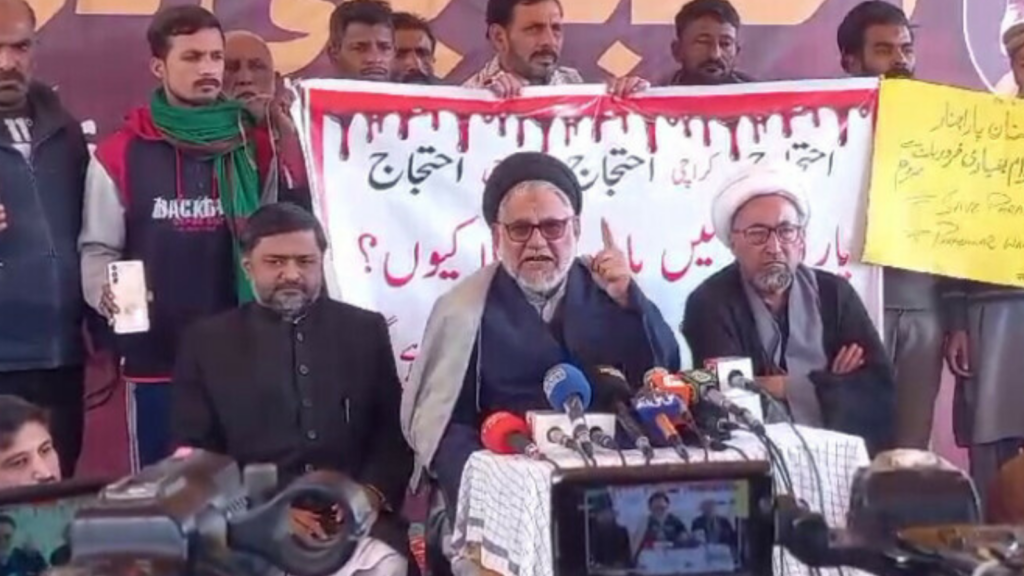Karachi’s Protests Against Parachinar Killings Ease as Several Routes Reopen
Sit-in protests in support of the people of Parachinar, Khyber Pakhtunkhwa, have caused major disruptions in Karachi in recent days. Traffic has stopped in several areas of the city due to the protests, which were sparked by the continued unrest in Kurram District and the terrible deaths of two people who were later decapitated in the Bagan region. However, after police warnings and administrative actions, a number of highways were reopened to traffic on Tuesday, bringing some semblance of normalcy back.
Context of the Protests
The religiopolitical Majlis Wahdat-i-Muslimeen (MWM) organized the demonstrations to draw attention to Parachinar’s worsening law and order situation. Residents of Parachinar have been holding sit-ins since December 20 to call for the immediate reopening of important highways and the resolution of security-related issues. The horrific event of the two decapitated victims served as a focal point for national indignation as the violence in Kurram District increased in recent months.
The MWM’s appeal for unity in Karachi led to sit-ins at 13 different locations, which significantly disrupted everyday life and traffic flow. Demonstrators have insisted that they will not stop until their demands—which include the restoration of Kurram’s blocked roads—are fulfilled.
Road Reopenings and Updates on Traffic
- Six of the thirteen sites that had been blocked by protestors had been made accessible to cars as of Tuesday, according to Karachi Traffic Police. The following roads have been reopened: Jauhar Mor to Jauhar Chowrangi Five-Star Chowrangi in North Nazimabad
- Wahab Siddique Ali Khan Road in Nazimabad-1 heading towards Nazimabad; Shamsuddin Azeemi Road approaching KDA Flats in Surjani Town-2 Ayesha Manzil and Ancholi on Shahrah-i-Pakistan
Protests continued at four strategic locations throughout the city, generating ongoing disturbances in spite of these advances. M.A. Jinnah Road near Numaish Chowrangi in District East was still closed, and Capri Cinema offered other routes to Soldier Bazaar and Saddar Dawa Khana. Similarly, vehicles had to veer via University Road and inner streets close to Munawar Chowrangi since Kamran Chowrangi in Gulistan-i-Jauhar was impassable.
Both tracks leading to the Superhighway on District Malir’s Abul Hasan Ispahani Road were closed at Abbas Town. From Paradise Bakery, alternate routes were established via service lanes close to Punjab Adda and to Fariya Chowk. Additionally, University Road was closed, with detours via residential streets, especially the section adjacent to the Samama Shopping Center and the Nipa roundabout.
Demands for Coordinated Demonstrations
Local officials and the chief of police in Karachi have asked demonstrators to plan their events so as not to impede traffic. In response to these pleas, MWM leader Allama Hassan Zafar Naqvi told demonstrators to maintain one side of the highways open. Although this order reduced traffic in some areas, Naqvi reaffirmed that the sit-ins would go on until the citizens of Parachinar’s requests were met.
To allow for public transit, a large sit-in at Sharea Faisal, close to Natha Khan Bridge, was called off. The situation is still unstable, though, since the banned Ahle Sunnat Wal Jamaat (AWSJ) has organized counter-protests at 60 locations throughout Karachi, which might further exacerbate tensions.
Government Reaction
Murad Ali Shah, the chief minister of Sindh, has been keeping a close eye on the situation. He stated during a press conference in Thatta that as of Tuesday, there were four continuing sit-ins after protests at eight locations had concluded. While acknowledging the challenges citizens were facing as a result of these protests, the chief minister underlined the significance of striking a balance between administrative action and communication.
At four sites, the sit-ins are still going on. “We are speaking with them and, where necessary, taking some administrative action, which may also upset people.” His comments highlight the government’s attempts to allay the demonstrators’ worries while causing the least amount of disturbance to daily life.
Wider Consequences
The precarious status of law and order in Kurram District has come to light as a result of the protests over the Parachinar killings and the ensuing rallies in Karachi. Residents in the area have long demanded government assistance due to sectarian violence and insecurity. Calls for justice and structural changes have been rekindled by the recent decapitation event.
The protests in Karachi have brought to light the difficulties of overseeing sizable gatherings in a vast city. Even though several routes have been successfully reopened by the government, the demonstrators’ enduring annoyance is demonstrated by the sit-ins. In addition to adding complications, the involvement of organizations such as the MWM and AWSJ raises the possibility of additional escalation due to ideological and political rivalry.
The Path Ahead
As the demonstrations go on, a comprehensive strategy is needed for a long-term solution. The security issues in Kurram District must be addressed first and foremost by the federal and provincial administrations. This entails reopening routes that have been blocked, making sure that passengers are safe, and taking firm action against those who are behind the recent violence.
To find common ground, Karachi’s local officials need to talk to the leaders of the protests. Maintaining order in the city requires striking a careful balance between permitting nonviolent protests and causing the least amount of disruption to the general population. The government’s ability to handle more general concerns about public safety and governance will be judged by how well it handles these protests.
In conclusion
Karachi’s protests have subsided, which is a step in the right direction, but the fundamental problems that led to these protests have not been addressed. The outcry that followed the assault in Parachinar is a reflection of the long-standing issues that Pakistan’s underprivileged populations face. In addition to prompt administrative action, addressing these issues calls for a sustained dedication to justice, security, and equitable development. Only then would it be possible to break the cycle of protest and violence and create a more peaceful and prosperous future.

